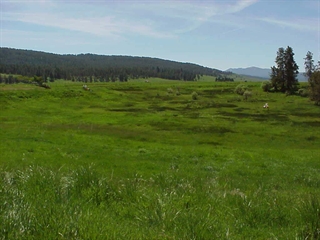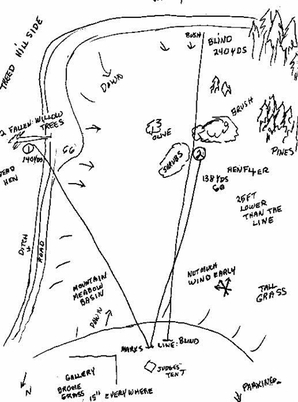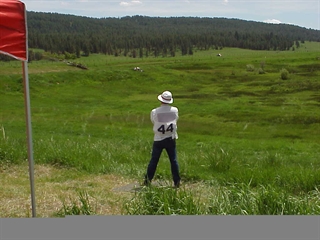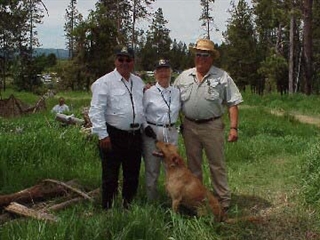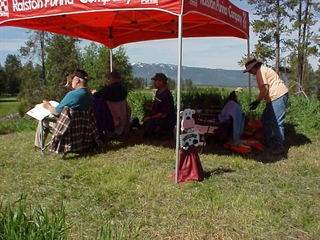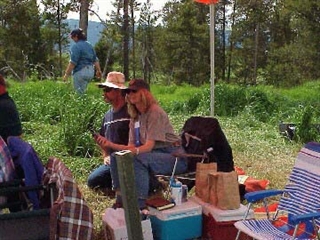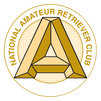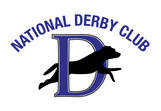Sunday, June 20, 1999 |
The 1999 National Amateur started precisely at 8:00 AM on Sunday, June 20, and Field Trial Chairman Dean Ellis was finally able to smile with relief. The hard work of the judges and the committees was all coming together.
The first test was held in a scenic basin just South of McCall. The two test dogs, AFC Plourde Honor O'Fox Hill Farm, and Super Sky Rocket, ran at 7:45 AM. Weather was clear, wind was very slight. Temperatures ranged from the 40's early morning, into the 80's later in the day.
The first test was a land double with a blind. The first bird was a dead hen pheasant, thrown from right to left, from the top of a bank, across a dirt road and a ditch with a hidden stream in the bottom, to a spot just in front of a large downed fir tree. The distance was about 140 yards; gunners did not retire. The flyer was a hen pheasant thrown in the flat; the fall was about 135 yards. The falls varied, with some landing in heavy cover (low brush) and others in the lighter grassy areas. The flyer was about 75 degrees off of the dead bird. The blind was basically run through the arc of the flyer. Many dogs handled on the left bird, with the work gradually improving after the first thirty or so dogs. The early dogs had no wind, and the hen pheasants offered little scent in the heavy grass, wet with dew.
The left-hand memory bird had several hazards. The curvature of the sidehill would make many dogs roll right, even if sent to the left. Many ran the ridge, while others 'channeled' the creek, swimming with the current and coming up behind the mark on the throwers' side.
The line to the blind could be over, under or by the flyer because of the variation in falls. Heavy bushes on the left side proved to be a substantial hazard. With the afternoon breeze the work improved on the blind and on the marks.
A special hand for the Grounds Committee. They had mowed a path from the parking area up the ridge to the test area, and built a log bridge over the creek between the parking area and the gallery. Some dubbed it the 'Ratzlaff Memorial Highway.'
GALLERY COMMENTS:
"Expect user friendly galleries all week." (Dean Ellis, Field Trial chairman). The gallery had excellent views of the whole test throughout the day.
"Early shadows hurt the left hand mark."
"Wet hen pheasants early were a problem."
"Having to punch across the road, then the ditch, caused many handles."
"The line to the blind varied--over, under, outside or through the flyer. The hens did not fly well, and did lack consistency."
"The yellow dogs really showed well! The field was very green."
"The blind trailed up early. There were several line jobs in the first 10 dogs. (Examples: Code Blue, Gunstock's Winifox.) There were four handles in the first eight dogs on the left mark."
"The tree 'barrier behind the left mark was not the effect that the ditch was."
"The S curve at the end of the ditch would fool several dogs. They would go over the bank, into the ditch, and swim the current, then come up at the S curve, think they were coming out right, and come out on the gunners' side and behind them."
The judges suspended the test at 8:22 PM after Dog 100. Seven dogs are left to run. (Unofficially, resuming with the test dog at 6:30 AM!!!) No partial callbacks were given.
The first test was a land double with a blind. The first bird was a dead hen pheasant, thrown from right to left, from the top of a bank, across a dirt road and a ditch with a hidden stream in the bottom, to a spot just in front of a large downed fir tree. The distance was about 140 yards; gunners did not retire. The flyer was a hen pheasant thrown in the flat; the fall was about 135 yards. The falls varied, with some landing in heavy cover (low brush) and others in the lighter grassy areas. The flyer was about 75 degrees off of the dead bird. The blind was basically run through the arc of the flyer. Many dogs handled on the left bird, with the work gradually improving after the first thirty or so dogs. The early dogs had no wind, and the hen pheasants offered little scent in the heavy grass, wet with dew.
The left-hand memory bird had several hazards. The curvature of the sidehill would make many dogs roll right, even if sent to the left. Many ran the ridge, while others 'channeled' the creek, swimming with the current and coming up behind the mark on the throwers' side.
The line to the blind could be over, under or by the flyer because of the variation in falls. Heavy bushes on the left side proved to be a substantial hazard. With the afternoon breeze the work improved on the blind and on the marks.
A special hand for the Grounds Committee. They had mowed a path from the parking area up the ridge to the test area, and built a log bridge over the creek between the parking area and the gallery. Some dubbed it the 'Ratzlaff Memorial Highway.'
GALLERY COMMENTS:
"Expect user friendly galleries all week." (Dean Ellis, Field Trial chairman). The gallery had excellent views of the whole test throughout the day.
"Early shadows hurt the left hand mark."
"Wet hen pheasants early were a problem."
"Having to punch across the road, then the ditch, caused many handles."
"The line to the blind varied--over, under, outside or through the flyer. The hens did not fly well, and did lack consistency."
"The yellow dogs really showed well! The field was very green."
"The blind trailed up early. There were several line jobs in the first 10 dogs. (Examples: Code Blue, Gunstock's Winifox.) There were four handles in the first eight dogs on the left mark."
"The tree 'barrier behind the left mark was not the effect that the ditch was."
"The S curve at the end of the ditch would fool several dogs. They would go over the bank, into the ditch, and swim the current, then come up at the S curve, think they were coming out right, and come out on the gunners' side and behind them."
The judges suspended the test at 8:22 PM after Dog 100. Seven dogs are left to run. (Unofficially, resuming with the test dog at 6:30 AM!!!) No partial callbacks were given.

